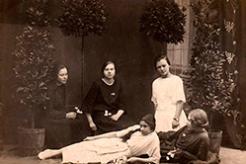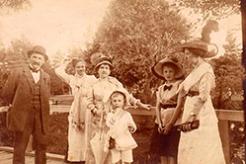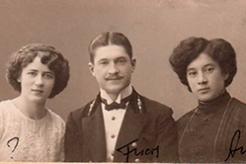




Author: Pēteris Korsaks
In terms of its importance, the invention of photography may be compared to the invention of writing or the invention of wheel. The growth of photography in the territory of Latvia in early 20th century is closely related to general upswing of photography in Western Europe and favourable location of Latvia in the European map. A year after the discovery of the photography in 1839 in Paris, Domenico de Robiani displayed the first photographs in the world in Riga – daguerreotypes.
The introduction of photography in the territory of Latvia relates to the New Latvians movement. During the first Latvian National Awakening period Latvians started identifying themselves as a nation and fought for the development of national culture.
“Soon after the establishment photography developed rapidly from the technical perspective and it had been widely applied in various fields: forensic medicine, ethnography, architecture, science etc. New means of visual expression spread rapidly regardless of national frontiers.”[1]
In 1907 Mārtiņš Buclers, the founder of Latvian photography, wrote that “photography spread with great speed, found friends among all classes of people, photography was much cheaper alternative to painting when it comes to portraits. Consequently, the advantage of the prosperous became available to anyone.”[2]
Latvian painters also considered the opportunities given by the photography as good. In 1970s, Jūlijs Feders, the founder of Latvian realistic landscape painting, earned extra money by taking portrait photographs in his studio in Jelgava. Within longer research period this fact was proved as some of his photographs were detected.
There is evidence that Jānis Rozentāls has also used the modern tool, namely, photo camera. He captured impressive landscapes or personalities and then painted them. In 1895 in Saint Petersburg he took a photo of the famous painter Johans (Jānis) Valters. From 1901 until 1904 painter Indriķis Zeberliņš had been working at Leibovics in Liepājas a photographer and skilful retoucher. Besides, it is also known that poets Kārlis Krūza and Jānis Ziemeļnieks worked as photographers.
During the second part of the 19th century various photographic societies operated in London, Vienna, Paris, Saint Petersburg, as well as in Riga: Riga German Photographic Society (Photographische Gesellschaft zu Riga) and Latvian Photographic Society. Due to strategically advantageous position, at the crossroads of land roads and sea roads between the East and the West, Riga developed into an industrial city. In the 19th century in the territory of Latvia the majority of photographers were Germans, both local and those travelling to Saint Petersburg, Warsaw and Moscow via Riga. During the season they opened photographic studios as the demand grew.
At the end of the 19th century photography became more and more popular also among Latvians, such as Mārtiņš Buclers, Roberts Johansons, Kārlis Andersons, who acquired the profession by means of self-learning or under the leadership of German photographers. Interest in this new discovery – photography – was tremendous, and before the World War I the number of photo studios in Riga exceeded 60. Wealthy German photographers, such as Karl Hebensperger, Karl Schulz, Emanuel Eggert, Leonard Wyrzykowsky, Wladislaw Malinowski a.o., worked in the city centre. Whereas, Latvian photographers were found in Riga suburbs and other places in Latvia, among them Mārtiņš Lapiņš in Grīziņkalns, Jānis Rieksts and Indriķis Baumanis in Torņakalns, Voldemārs Priede in Schreienbusch (Čiekurkalns), Eduards Zariņš in Alūksne, Oskars Priedītis in Vecgulbene, Ferdinands Knoks in Galgauska, Jānis Sarkangalvis in Valmiera, Alfrēds Grāvers in Lubāna, Dāvis Spunde in Strenči and others.
More information will be available in the virtual exhibition, which will be established till April 2016.
[1]Korsaks, P. Fotogrāfija Latvijā // Jūgendstils. Laiks un telpa. – Rīga: Jumava,1999. ̶ 183.lpp.
[2]Buclers, M. Portreja // Stari. – 1907. – Nr. 5 – 393.lpp.